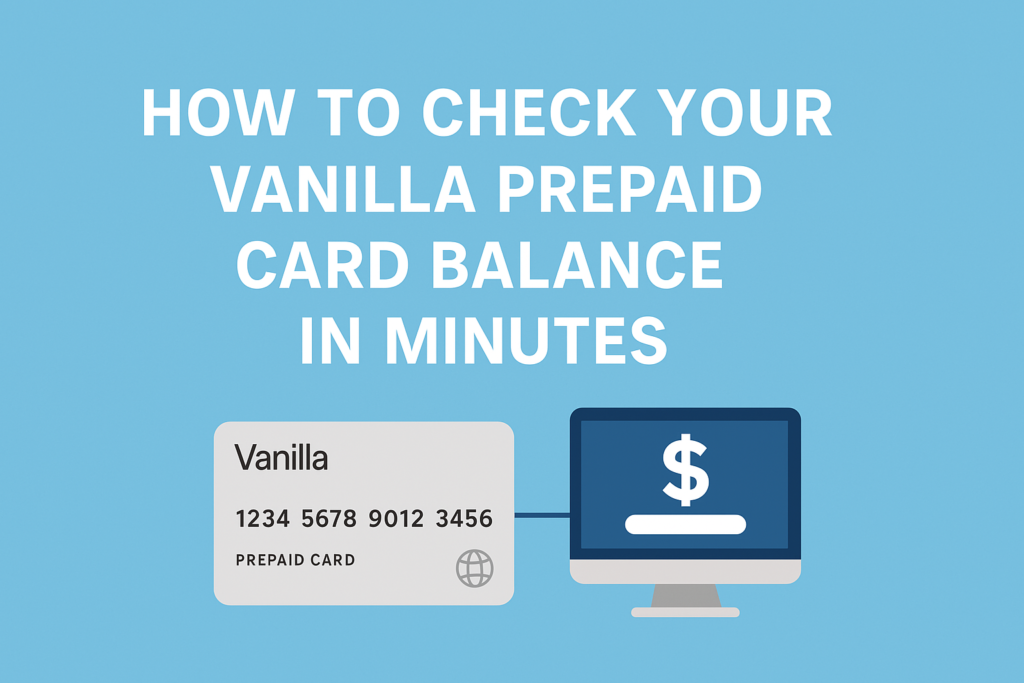Gift cards for holidays, birthdays and all kinds of events are popular now days! With so many choices to choose from, comparing all the different types of gift cards can be overwhelming. The vanilla vs visa gift card comparison is a significant consideration of every consumer hoping to make the appropriate choice. Knowing the differences between Vanilla gift cards and standard Visa/Mastercard gift cards will help you identify which one is appropriate for you.
What Are Vanilla Gift Cards?
Vanilla gift cards are prepaid debit cards issued by InComm Payments, a leading financial technology company. Despite the “Vanilla” branding, these cards actually run on either the Visa or Mastercard payment networks, which means they have the same wide acceptance as traditional network-branded cards.
The term “Vanilla” refers to the issuing company and card design, not to any limitations on usage. These cards are called “vanilla” because they offer a straightforward, no-frills approach to prepaid cards without complex features or restrictions.
features of branded cards.
The “vanilla” reference in the card name does not apply to any use restrictions or limitations; instead, the Vanilla gift card refers to the issuing company and the card design.
Vanilla gift properly depicts something which is simple and uncomplicated, that simply offers vanilla prepaid cards without additional, complicated features!
Understanding Visa and Mastercard Gift Cards
Visa and Mastercard gift cards are traditional prepaid payment cards that banks, credit unions, or licensed financial institutions issue. Although the card is a gift card, you’ll see that it bears the official Visa or Mastercard logo, and it is accepted in the same networks and follows the same security standards.
When you buy Visa or Mastercard gift cards, you are purchasing a prepaid card that will call pre-loaded funds on your card instead of calling on a bank account or credit line. Visa and Mastercard gift cards are similar to debit cards because they basically process payments for low-value purchases from a loaded balance at a financial institution without requiring a bank account relationship.
What Are Traditional Visa/Mastercard Gift Cards’ Features
Generally, direct-issued Visa and Mastercard gift cards have full customer care support through the issuing bank or financial institution. In addition to a full-service level of customer care, they have many of the key benefits that you would normally associate with two of the world’s major payment card services, including a number of fraud protection features. There may be various additional features depending on the issuing institution, including purchase protection or extended warranty benefits.
Most fees make it easy to fully manage your card online, and at a minimum monitor your balance and transaction history. You also may be able to set alerts to notify you about certain events on your account. During your initial registration, you may have the option to create additional security features and streamlining the process if you happen to lose your card or it is stolen.
Vanilla vs Visa Gift Card: Important Differences
There are a few important differences to pay attention to when comparing vanilla and visa gift card products that can determine which is the best option for you. By differentiating these subtle variations, you can select the card that is best suited to your needs.
Entity of Issuance and Brand
The most apparent difference is the entity of issuance and brand. Vanilla gift cards are issued by InComm Payments therefore use the Vanilla brand, while traditional visa/mastercard gift cards are issued by various banks and financial institutions directly licensed by the network.
This difference of issuer may affect your customer support experience, since you may have a full customer service offering from bank issued cards due to bank relationships, while vanilla gift card may have a streamlined version of this customer support with a service representative focused on prepaid card management.
Card Design and Packaging
Vanilla gift cards typically have a simple and contemporary design and presentation with the Visa or Mastercard network symbol once opened, along with the Vanilla logo clearly marked. Traditional network gift cards have the banks branding with the payment network logo, usually with a variety of designs and more customizing options, seasonally.
Customer Service and Support
When comparing vanilla and visa gift cards, there are some distinctions in customer service processes. For vanilla cards, customer support is dedicated solely to dealing with prepaid cards and is trained specifically for prepaid card issues. Bank issued visa/mc cards on the other hand will have extended transactional knowledge and experience, however, there are possible longer wait times, since bank customer support will also be dealing with other banking products besides prepaid cards.
Fees and Costs Comparison
Fees are one of the major issues to consider when making decisions regarding vanilla vs visa gift cards. Generally, the fee structure for both types of cards tends to be similar. However, with each issuer, the amounts and types of fees charged can vary quite significantly.
Activation Fees
Most types of gift cards, regardless of the fees, charge an activation fee. Vanilla gift cards usually charge activation fees from $4.95 to $6.95, depending on the value of the card and the retailer. Traditional issuer visa/mc gift cards charge similar activation fees, even some premium cards may charge higher activation fees than standard vanilla fees.
Monthly Maintenance Fees
Many gift cards start charging you monthly maintenance fees for using the card after a period of no activity, however, the inactivity periods are usually for 12 months. Vanilla cards charge $2.50 a month for inactivity after one year, however, bank issued cards have different fees and practices and can vary depending on the customer support. Some premium cards choose to offer free maintenance fees, while some are charging higher than normal amounts for maintenance.
Transaction and ATM Fees
Both types of cards usually allow ATM withdrawals with fees. These fees typically range between $2.50 – $3.00. Many card brands also charge fees for balance inquiries and declined transactions, but this is less common with reputable card issuers.
International Usage Fees
For those traveling abroad, international transaction fees should be a factor in choosing card types. Generally, most Vanilla gift cards and standard Visa/Mastercard gift cards will charge a foreign transaction fee of 2-3% when used outside of The United States. However, there are premium cards that do not charge foreign transaction fees.
Where to Buy Each Type
Availability and locations to purchase Vanilla gift cards versus traditional Visa/Mastercard gift cards are very different and will impact consumer convenience and accessibility.
Vanilla Gift Card Retailers
Vanilla gift cards are available at major retailers including Walmart, Target, CVS, Walgreens, and thousands of grocery stores and gas stations across the country. It is also possible to purchase Vanilla gift cards online at their Official website, or other authorized retailers.
The retail availability makes Vanilla cards extremely convenient to purchase at the last minute, or while shopping for other things. Vanilla cards are also offered at retailers in various denominations, and during holiday seasons many retailers offer promotional bonuses with a Vanilla card purchase.
Sources of Conventional Visa &&Mastercard Gift Cards
Bank-issued Visa and Mastercard gift cards mostly come from banks, credit unions, and their online sites. There are some major retail sources, but the selection is not as broad as what you’d find in Vanilla cards.
There are a lot of online purchase options, and most of the major banks will sell directly online with shipping options. Several banks also allow current customers the option of ordering gift cards through their online bank and mobile banking apps as well.
Use and Acceptance
For merchant acceptance, the vanilla cards versus visa gift cards comparison shows no real practical difference. Both are accepted by merchants based on the same underlying payment networks.
Online Shopping
The vanilla gift cards and regular Visa/Mastercard gift cards are valid for online purchases. The one difference is that users must register their cards online to allow for e-commerce uses, which also requires users submit their billing address information. Thereupon the user can shop online.
Online shopping with either type of card, follows the same procedures as using a standard credit or debit card, which means the user must enter the card number and expiration date and CVV code. Although in general it is common for some websites to limit prepaid cards, this would include both forms of gift card.
In-Store Purchases
In-Store retail acceptance is almost identical for both gift card types. Any merchant that accepts a Visa or a Mastercard, will accept either of these gift card types, as long as the user has enough balance on the gift card.
The sole consideration for in-store use is that most merchants cannot process gift card payments as a partial payment, meaning, the total amount must be available on the gift card account or the balance must be processed through some alternative means.
Recurring Payments and Subscriptions
These two kinds of cards may both be used for recurring payments like gym memberships, streaming services, or insurance, but that may depend on the merchant and their policy on prepaid cards. Users should avoid using gift cards for these kinds of charges because if they underestimate their usage, it may impede service.
Security Features
When it comes to any payment system, one of the more important aspects is security. And for a vanilla vs visa gift card comparison, while they can both have similar security arrangements, they are still not identical.
Fraud Protection
Both Vanilla and Visa/Mastercard gift cards offer zero liability against unauthorized purchases, provided the cards have been registered and you report it lost or stolen. Depending on the issuer, the claim process and time for the refund may vary.
Because unregistered cards can usually not be guaranteed for anything, especially if lost or stolen, it is paramount you’ve registered the card so you’ve got security and somewhat of a path to recovery. Should a card become unregistered and you’ve lost or stolen it, you can obtain a replaced card but, depending on the card, you often have to pay a replacement fee.
EMV Chip Technology
Modern versions of both types of cards are likely to include some EMV chip technology and security for point-of-sale purchases. When you use an EMV card in a store, the chip generates a unique code for complex purchases. This makes it extremely difficult for adroit criminals to manufacture counterfeit cards.
Online Safety Functions
Registered cards of both types offer online account management, secure login credentials, transaction alerts*, and temporary locking of the cards if suspicious activity is detected. Some issuers have their own mobile apps that have added features, like biometric security.
Pros and Cons
Vanilla Gift Cards
Advantages :
- Wide availability in retail stores providing a convenient purchase option
- Market competitive fee levels and transparency in pricing
- Simple registration and good user online-management capabilities
- Consistent customer service that focuses solely on prepaid cards
- Clean, professional looking card design suitable for gifting
Disadvantages:
- Less customizable than some types of bank cards
- May not have the same premium features as bank cards.
- An issuer is not as big a player as major banks, which may be a concern for some users.
Traditional Gift Cards (Visa/Mastercard)
Advantages:
- Are backed by financial institutions with established business practices and resources.
- May have additional benefits, e.g. purchase protection, extended warranties, etc.
- May provide more personalized service based on business relationships.
- Availability of custom designs or custom corporate branding.
- May offer more flexible replacement policies.
Vanilla Mastercard Balance – How to Check & Manage in 2025
Check Vanilla Gift Card Balance Online
Vanilla Prepaid Card Balance
Disadvantages:
- May be more difficult to purchase than Vanilla Cards.
- Might have a higher fee, depending on the issuing bank.
- Customer service might not be as specially trained in dealing with gift card issues.
- Might offer less store options for purchase.
Which One Should You Pick?
In the end, it comes down to your specific needs, wants and situation. Both Vanilla gift cards and Visa gift cards provide the prepaid card functionality that allows the widest merchant acceptance.
Use Vanilla gift cards if you care about convenience, low fees, and a simple process. They are good choices for last-minute gifts, readily available anywhere and offer excellent value for most people. Relative to Visa gift cards, the simple process that allows for good customer service makes them an attractive choice for people looking for a no-hassles experience.
Use traditional Visa/Mastercard gift cards if you want the backing of traditional financial institution, want an additional benefit potentially or require some specific functionality such as a custom design for corporate giveaways. They are probably the better option if you plan on giving a more expensive gift or one where customer service is a top priority.
For the average consumer, Vanilla gift cards offer the best balance of convenience, cost & utility. But both cards serve their own purposes well and deliver reliable prepaid payment options.
Frequently Asked Questions
Q: Can I use both cards internationally? A: Yes, Vanilla gift cards and Visa/Mastercard gift cards can both be utilized internationally, wherever the respective payment networks are accepted (although foreign transaction fees generally apply).
Q: Do these cards have expiration dates? A: Both types of cards typically have expiration dates printed on them (usually 2 -3 years from date of receipt). However, gift card laws in many states, mean the funds do not expire.
Q: Can I reload these cards after the initial balance is used? A: Most gift cards of both types are not reloadable, and once the balance is spent, it cannot be used again.
Q: What happens if my card is lost or stolen? A: Both cards types can normally be replaced for a fee if it’s registered. Unless registered, a lost or stolen card usually cannot be replaced, so registration is important.
Q: Are there purchase restrictions? A: Typically both card types cannot be used to purchase other prepaid cards, money orders, or cash equivalents. Some retailers may also restrict them from specific categories like gambling.
Q: How do I check my balance? A: Both types of cards have several ways to check the balance- online portal, mobile application, customer service phone line, or sometimes using ATM.
The vanilla vs visa gift card comparison shows that both options offer valuable prepaid payment solutions with their own advantages and considerations. Making an informed choice based on your specific needs will ensure you select the best gift card option for your situation.


